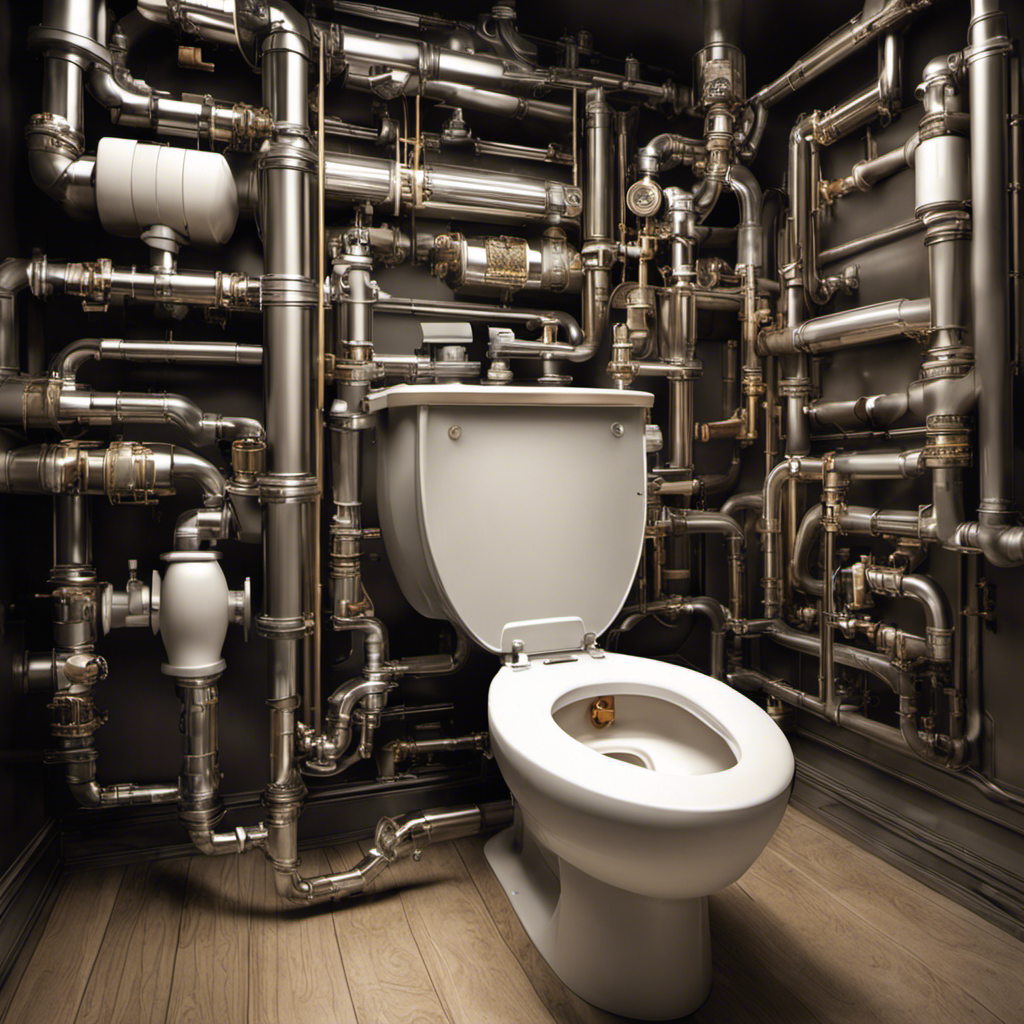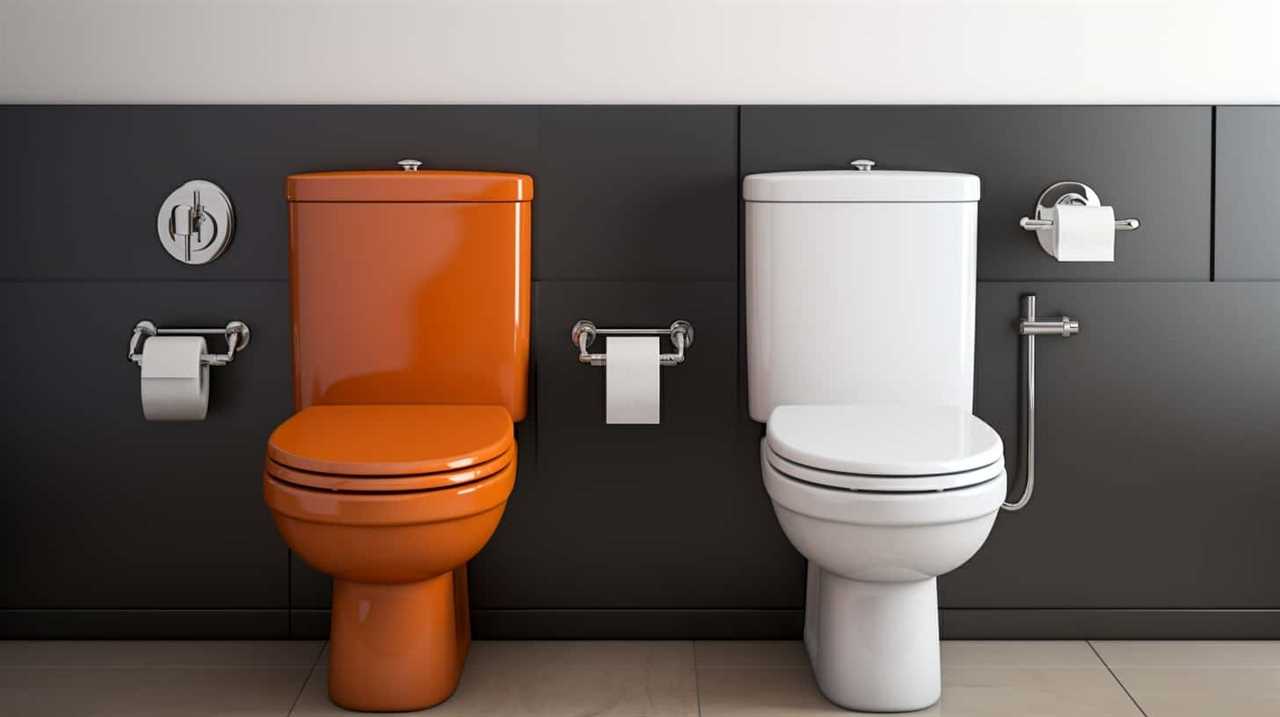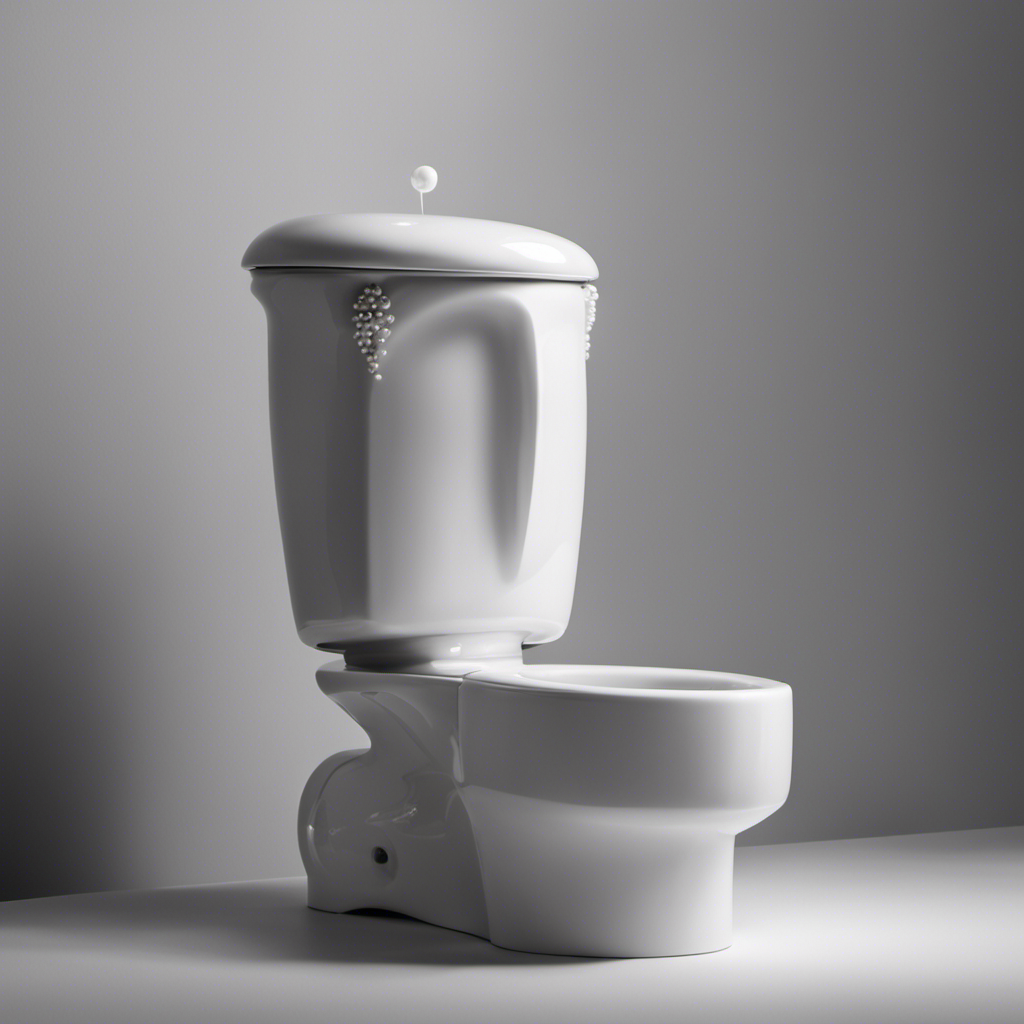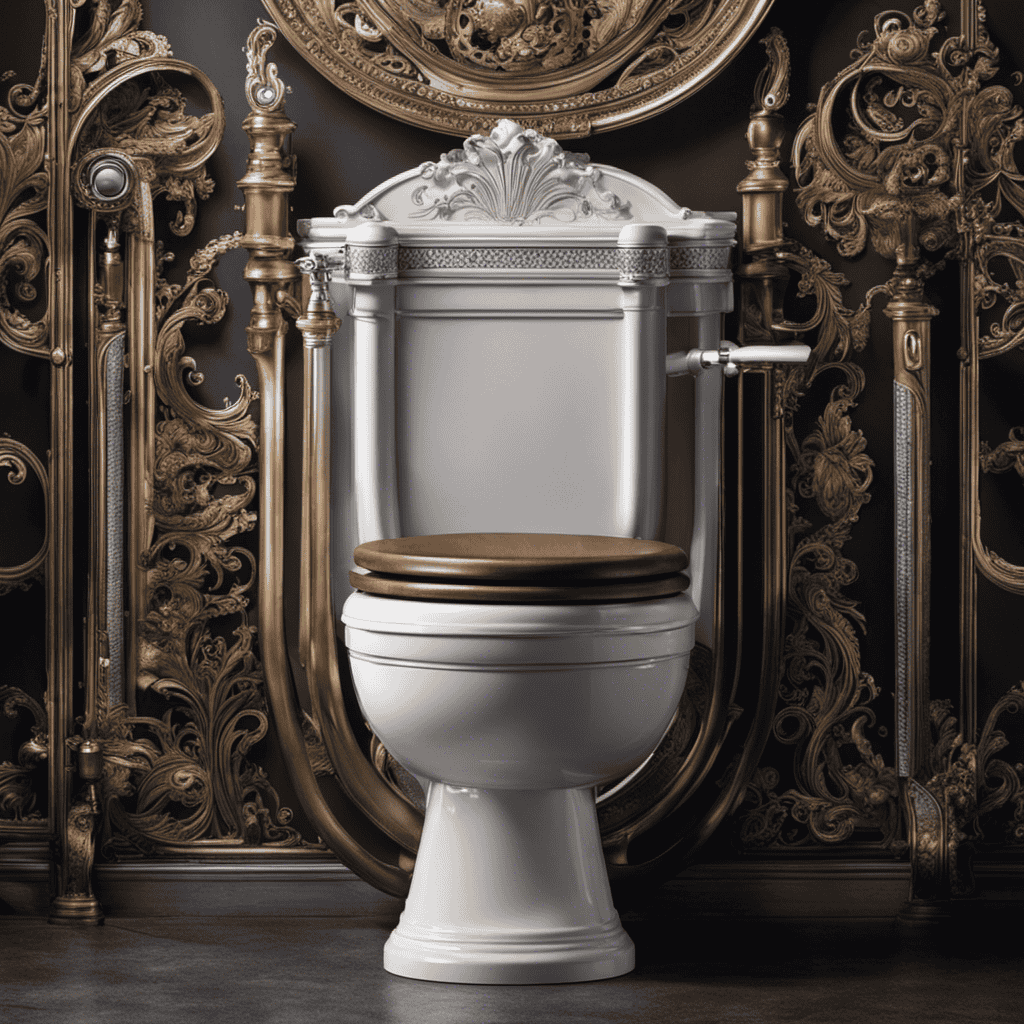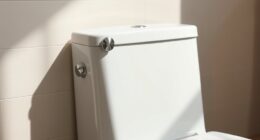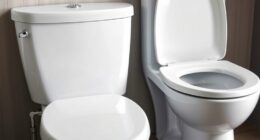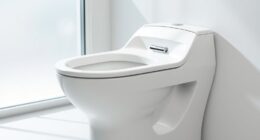Hey there! Ever wondered why your toilet seems to have a mind of its own, making all sorts of strange noises? Well, you’re not alone. Trust me, I’ve been there.
In this article, we’ll dive into the common causes of noisy toilets and how to fix them. From dealing with pesky toilet tank fill valve issues to troubleshooting flushing problems, we’ve got you covered.
So, let’s get to the bottom of this (pun intended) and silence that noisy commode once and for all!
Key Takeaways
- Noisy toilets can be caused by faulty fill valves, high water pressure, toilet tank vibrations, and debris or sediment buildup.
- Water hammer, which is a loud banging noise, can occur when the water flow abruptly stops due to high water pressure or a sudden reversal of water direction.
- Adjusting the fill valve height can help reduce noise by decreasing or increasing the water level in the tank.
- If the fill valve is faulty, it may need to be replaced to fix the noise issue, and proper fill valve maintenance is important for proper toilet functioning.
Common Causes of Noisy Toilets
One common cause of noisy toilets is a faulty fill valve, which can be easily replaced. When the fill valve is worn out or damaged, it may not fully shut off the water flow after a flush, leading to a continuous hissing sound. This noise can be quite annoying, especially if the toilet is located near a bedroom or living area.
Another cause of toilet flush noise is toilet tank vibrations. This happens when the water pressure is too high, causing the tank to shake and create a loud rattling sound during and after flushing.
Understanding the different causes of noisy toilets is important in order to address the issue effectively and restore peace and quiet to your bathroom.
Now, let’s explore the concept of toilet water hammer.
Understanding Toilet Water Hammer
Toilet water hammer occurs when the water flow is abruptly stopped, causing a loud banging noise. This phenomenon is often a result of high toilet water pressure and can be quite bothersome. The noise is caused by the sudden reversal of water direction due to the closing of the toilet valve.
When the flow is suddenly halted, the water momentum creates a pressure wave that travels through the pipes, resulting in the loud bang. To prevent toilet water hammer, it is important to regulate the water pressure in your plumbing system. This can be done by installing a water hammer arrestor or adjusting the water pressure regulator.
By addressing the issue of high water pressure, you can effectively minimize the occurrence of toilet valve noise and ensure a quieter bathroom experience.
Moving on to dealing with toilet tank fill valve issues, let’s explore some common problems and solutions.
Dealing With Toilet Tank Fill Valve Issues
When it comes to dealing with toilet tank fill valve issues, there are several key points to consider.
First, if you are experiencing a noisy fill valve, there are solutions available to help reduce the noise. These can include adjusting the water pressure, insulating the valve, or even replacing the fill valve altogether.
Second, adjusting the fill valve height can be a simple yet effective solution for a toilet that is either constantly running or not filling up enough.
Noisy Fill Valve Solutions
If your toilet’s fill valve is making noise, there are a few solutions you can try. The fill valve is responsible for regulating the water flow into the toilet tank, and when it malfunctions, it can cause noise and disrupt the quiet operation of your toilet. One common issue is a loose or worn-out fill valve washer, which can be easily replaced. Another solution is to adjust the water level in the tank by either lowering or raising the fill valve float. Additionally, cleaning the fill valve and removing any debris or sediment buildup can help restore quiet toilet operation. If these solutions don’t solve the problem, it may be necessary to replace the fill valve altogether.
| Solution | Description |
|---|---|
| Replace fill valve washer | Replace the worn-out washer to eliminate noise |
| Adjust water level | Raise or lower the float to adjust water level |
| Clean fill valve | Remove debris and sediment to restore quiet operation |
Adjusting Fill Valve Height
One way to address the issue of a noisy fill valve is by adjusting its height to regulate the water flow. Toilet fill valve troubleshooting often involves finding the right water level in the tank.
If the water level is too high, it can cause the fill valve to make a loud hissing or screeching noise. To adjust the fill valve height, locate the water level adjustment screw on top of the fill valve. Use a screwdriver to turn the screw clockwise to decrease the water level or counterclockwise to increase it.
It’s important to make small adjustments and test the noise level after each adjustment. By adjusting the toilet tank water level, you can find the optimal height for the fill valve and eliminate the noise.
Replacing Faulty Fill Valve
To fix a noisy fill valve, start by replacing it with a new one. Fill valve maintenance is essential to ensure proper functioning of your toilet.
A faulty fill valve can cause various issues, including noise. Signs of a faulty fill valve include constant running water, weak flush, and water levels that are too high or too low in the toilet tank.
Replacing the fill valve is a relatively straightforward process. First, turn off the water supply to the toilet. Next, drain the tank by flushing and soaking up any remaining water. Disconnect the supply line and unscrew the old fill valve.
Install the new fill valve, reconnect the supply line, and turn the water supply back on. This should resolve the noise issue and restore proper functioning to your toilet.
Fixing a Running Toilet
There’s a simple fix for a running toilet that involves adjusting the float. Here are three steps to help you resolve the issue:
-
Check the toilet flapper: The flapper is a rubber valve that controls the flow of water from the tank to the bowl. If it’s worn out or not sealing properly, it can cause the toilet to run continuously. Inspect the flapper for any signs of damage or debris and replace if necessary.
-
Adjust the water pressure: Excess water pressure can lead to a running toilet. Locate the water supply valve behind the toilet and turn it clockwise to reduce the pressure. Make sure to find the right balance to prevent any other issues.
-
Adjust the float: The float is a small plastic or metal device that controls the water level in the tank. If it’s set too high, it can cause the toilet to continuously run. Adjust the float by bending the float arm downwards or adjusting the screw on top of the float assembly.
Troubleshooting Toilet Flushing Problems
Now that we have discussed how to fix a running toilet, let’s move on to troubleshooting toilet flushing problems. When your toilet doesn’t flush properly, it can be frustrating and inconvenient. Luckily, there are several common issues that can be easily resolved.
One common problem is a clogged toilet. This can happen when there is a blockage in the drain pipe, preventing water from flowing freely. To resolve this, you can try using a plunger or a toilet auger to remove the clog. Another issue you may encounter is a malfunctioning flush handle. If the handle is loose or not working properly, it may need to be tightened or replaced.
To further assist you, here is a table that summarizes some common toilet clog solutions and toilet flush handle problems:
| Clog Solutions | Flush Handle Problems |
|---|---|
| Plunger | Loose handle |
| Toilet auger | Stuck handle |
| Drain cleaner | Broken handle |
| Enzymatic cleaner | Handle not flushing |
By addressing these issues, you can ensure that your toilet flushes properly and efficiently. However, if you are still experiencing problems, it may be necessary to address other potential issues, such as toilet gurgling and bubbling sounds.
[Transition into the subsequent section about addressing toilet gurgling and bubbling sounds.]Addressing Toilet Gurgling and Bubbling Sounds
If you hear gurgling or bubbling sounds coming from your toilet, it could be a sign of a deeper plumbing issue that needs to be addressed. These noises are often caused by toilet venting problems or toilet drain blockages. Here are three possible reasons why your toilet is making these sounds:
-
Blocked Vent Pipe: The vent pipe allows air to enter the plumbing system, preventing a vacuum from forming and enabling wastewater to flow smoothly. If the vent pipe becomes blocked, it can cause gurgling or bubbling sounds in the toilet.
-
Clogged Toilet Drain: A clogged drain can disrupt the normal flow of water, leading to air bubbles and gurgling sounds when you flush the toilet. This can be caused by a buildup of debris or a blocked sewer line.
-
Vent Stack Issues: The vent stack is a vertical pipe that connects to the vent pipe and extends through the roof. If the vent stack is damaged or obstructed, it can cause air pressure imbalances and result in gurgling or bubbling noises in the toilet.
If you experience these sounds, it is best to contact a professional plumber to diagnose and fix the underlying issue before it worsens.
Conclusion
In conclusion, a noisy toilet can be quite a headache. But understanding the common causes and troubleshooting the issues can bring peace and quiet back to your bathroom.
Just like a skilled plumber unclogs drains and fixes leaks, you too can become the master of your own porcelain throne. Don’t let the unsettling sounds of gurgling and bubbling disrupt your daily routine.
With a little know-how and a few simple fixes, you can restore your toilet to its serene silence. It will be like a calm lake on a still summer evening.
